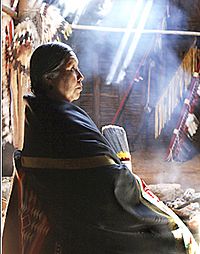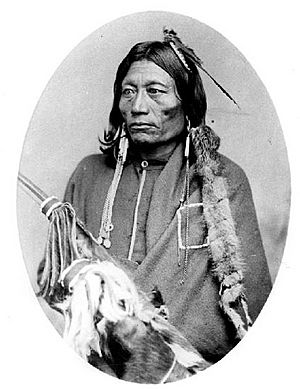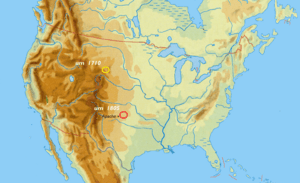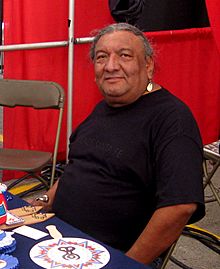Plains Apache facts for kids
| Total population | |
|---|---|
| 2,263 | |
| Regions with significant populations | |
| Languages | |
| English, formerly Plains Apache language | |
| Religion | |
| traditional tribal religion, Native American Church, Christianity | |
| Related ethnic groups | |
| Apache peoples, Navajo people, and other Athabascans. |
The Plains Apache are a Native American group. They live in the Great Plains of North America. They have a special connection with the Kiowa Tribe, even though they speak different languages. Today, most Plains Apache live in southwestern Oklahoma and northern Texas. Their tribe is officially recognized by the United States government as the Apache Tribe of Oklahoma.
Contents
What's in a Name?
The Plains Apache are also called the Kiowa Apache. They have other names too, like Naʼisha or Na i sha Tindé. This old name used to mean "thieves." However, today, the meaning of Na i sha is changing. It no longer means "thief."
They also used names like Kalth Tindé or γát dìndé, which means "cedar people." Another name was Bá-ca-yé, meaning "whetstone people."
The Kiowa tribe, who are close friends with the Plains Apache, called them Semat, meaning "stealers." When the tribes gathered for big events, the Kiowa Apache would set up their tipis (tents) in a special ring with the Kiowa. This might be why the Kiowa also called them Taugui, meaning "sitting outside."
How the Tribe is Governed
Today, the main office for the Apache Tribe is in Anadarko, Oklahoma. The tribe's official area covers parts of several counties in Oklahoma. These include Caddo, Comanche, Cotton, Grady, Jefferson, Kiowa, and Stephens Counties.
The current leader of the tribe is Bobby Komardley. To become a member of the tribe, a person needs to show they have a certain level of Plains Apache ancestry.
Tribal Businesses
The Apache Tribe has run businesses in the past. They used to have two casinos, the "Golden Eagle Casino" and the "Silver Buffalo Casino." These casinos closed in July 2013. The tribe also creates its own special license plates for cars.
A Look at History
In the early 1700s, the Plains Apache lived near the upper Missouri River. They were very close to the Kiowa people. Even though they were different groups and spoke different languages, they became allies. This friendship helped them protect each other from other tribes.
Many Kiowa Apache people did not learn the Kiowa language. Instead, they used a clever system called Plains Indian Sign Language to talk with their Kiowa friends. The Kiowa were very good at this sign language and might have even created much of it.
The Plains Apache tribe was never very large. In 1780, it was thought there were only about 400 of them.
Around 1800, the Kiowa Apache and Kiowa tribes moved into the Southern Plains. In 1867, a treaty called the Treaty of Medicine Lodge was signed. This treaty led to the Kiowa and Kiowa Apache settling in Western Oklahoma and Kansas. They were later made to move south of the Washita River to the Red River and Western Oklahoma, sharing land with the Comanche and Kiowa.
The time when they lived on reservations lasted from 1868 to 1906. It was hard for some families to change from their free life on the plains to a more restricted life on the reservation. By 1890, a count showed 326 Kiowa Apache people living on the Fort Sill reservation.
Some groups of Plains Apache did not want to live on reservations. They joined the Kiowa and Comanche in fights against the US Army. One famous battle was the First Battle of Adobe Walls. This was the biggest battle of the Indian Wars. It was also the last time Native Americans pushed back the US Army in the Southern Plains.
In 1966, the tribe formed a business committee. This helped them become officially recognized by the United States government again.
How They Organized Their Society
The Kiowa Apache people organized themselves into large extended families. These families were called kustcrae. Several families would camp together to hunt and gather food. These groups were called gonka.
The next level of organization was a division or band. This was a larger group of several gonkas that would come together. They did this for protection, especially during times of war. Before they lived on reservations, there were at least four gonkas that often joined forces to fight neighboring tribes and settlements.
Connection to Dismal River Culture
The Apache people are connected to something called the Dismal River culture. This culture existed in the western Plains. It is often linked to the Paloma and Cuartelejo Apache groups. Special pottery from the Jicarilla Apache has also been found at some Dismal River culture sites.
Some people from the Dismal River culture joined the Kiowa Apache in the Black Hills of South Dakota. Because of pressure from the Comanche in the west and the Pawnee and French in the east, the Kiowa and the remaining people of the Dismal River culture moved south. There, they later joined the Lipan Apache and Jicarilla Apache nations.
Language of the Plains Apache
The Kiowa Apache language is part of the Southern Athabaskan language family. This family is a branch of the larger Na-Dene languages. The Plains Apache language, also known as Kiowa Apache, was the most unique member of its language family.
Sadly, in 2006, only three people still spoke the language. The last person who spoke it fluently passed away in 2008.
Important Chiefs in History
- Gonkon (also known as "Apache John"). His full name was Gon-kon-chey-has-tay-yah, meaning "Man Over His Camp."
- Tsayaditl-ti (also called Ta-Ka-I-Tai-Di or Da-Kana-Dit-Ta-I - "White Man", born around 1830, died around 1900).
- Koon-Ka-Zachey (also called Kootz-Zah). This was a shorter version of his full name, Gon-kon-chey-has-tay-yah.
- Essa-queta (better known as Pacer or Peso, from Pay-Sus, died in 1875). Pacer was a leader of the Kiowa Apache tribe. He was part of the group that wanted peace. He kept most of the Kiowa Apaches on the reservation during the Red River War of 1874-75.
- Si-tah-le ("Poor Wolf")
- Oh-ah-te-kah ("Poor Bear")
- Ah-zaah ("Prairie Wolf")
Famous Tribal Members
- Vanessa Jennings: A talented artist who creates beadwork and traditional clothing. She is Plains Apache, Kiowa, and Pima.





